ABSTRACT
The sugar and alcohol sector has invested heavily in technologies to increase the productivity of sugarcane and consequently the gross income of sugar and alcohol; among these practices irrigation and fertilization stands out. The objective of this study is to evaluate the agro industrial and sugarcane yield (plant cane and first ratoon cycle) grown in the Sudoeste Goiano, Brazil, as affected by water replacement and nitrogen (N) rates; and to evaluate the residual effect from N rates on sugarcane ratoon grown under water replacement levels. The study was carried out with pots filled with a mixture of 120 kg of Oxisol (Rhodic Hapludox) and cattle manure, in a proportion of 3:1 v/v, respectively. A completely randomized design was used, 3x4, with three repetitions, analyzed in split plots. The treatments were combinations of three levels of replacement water (75, 50 and 25% of available water) and four N rates (0, 60, 120 and 180 kg ha-1, equivalent to pots), which were also the same doses for the treatment residual N rate. In both cycles, at harvesting the stem yield and the total recoverable sugar (TRS) were determined for calculation of gross income of sugar and alcohol. The plant cane was not affected significantly by any of the factors evaluated. Interactions between the residual N doses and water replacements influenced the TRS and the gross income of sugar and alcohol in ratoon cane, proving that the N applied on a cycle can be leveraged by another; the stem productivity was affected only by water replacements.
Key words: Residual nitrogen, sugar yield, alcohol yield, irrigation, stem productivity.
The sugarcane is a crop that stands out in Brazil for its great socioeconomic importance. Sugarcane constitutes the raw material for various byproducts and is responsible for a large share of biofuels used in the world. Currently, Brazil is the world largest sugarcane producer. In the 2014/2015 growing season, Brazil cultivated approximately 9.00 million hectares of sugarcane crop, harvesting 634.76 million metric tons.
The sugarcane yielded a total production of 35.56 million tons of sugar and 29.21 billion liters of alcohol. Goiás State has the second largest planting and production area for sugarcane in the country; they participate with 9.49% of the total area and 10.44% of production, being surpassed only by the São Paulo State (CONAB, 2015).
Currently, the main objective of the sugarcane industry is to increase productivity and reduce costs associated with the improvement of the quality of the raw materials and final products. To attain it, the agricultural and industrial areas must work together to obtain a higher quality and industrial yield.To achieve high income and productivity of sugarcane, it is necessary to combine the genetic and environmental factors, so that both can and are manipulated anthropically.
Genetics favor the cultivation associated with managements in various regions of Brazil and the world. Among the environmental factors, nitrogen fertilization and irrigation are some of the practices that have been increasing.
Consequently, researches have been developed in the search of information regarding the optimization of more rational use of water and nitrogen fertilizers, to maximize production, under technical, economic and environmental aspects. According to Oliveira et al. (2015), agriculture demands large quantities of water to supply the plant’s needs; and among the irrigated crops, sugarcane stands out for its responsive characteristics to irrigation.
There are lots of literature information on the response and benefits of N for sugarcane; however there still is no consensus on the crop response to the application of N fertilizers. Various authors have reported the response to the nutrient in general, are more frequent in cycles of ratoon sugarcane than in plant cane (Wiedenfeld, 1995; Franco et al., 2011; Teodoro et al., 2013).
The objective of the present study is to evaluate the productivity of stem and the agro industrial yield of sugarcane in the cycle of plant cane and first ratoon, grown in the SE region of the Goias State under different levels of water replacement via surface drip and different N rates as urea; and to evaluate the residual effect from N rate for first sugarcane ratoon.
Soil and weather conditions
The study was carried out in the Southwest region of Goiás state, Brazil, municipality of Rio Verde, from October 2013 to August 2014 (sugarcane plant cycle) and September 2013 to May 2014 (first sugarcane ratoon). Plastic pots with dimensions of 0.6 m (upper) diameter × 0.45 m (lower) diameter x 0.45 m (height), filled with a mixture of soil with cattle manure above the layer of gravel were used. The experiment was carried out in the open, in an experimental area belonging to the Instituto Federal Goiano, Campus Rio Verde, Goiás State, Brazil, situated at latitude 17°48'28" S and longitude 50°53'57" W, with average altitude of 720 meters. The climate of the region is classified (Koppen), as Aw (tropical), with rainfall in the months from October to May, and with drought from June to September. The annual average temperature ranged from 20 to 35°C and the rainfall varied from 1500 to 1800 mm annually. Figure 1 show the total precipitation accumulated in the cycles of the sugarcane, in function of the days after transplanting (DAT) for cane plant and days after cut (DAC) for first sugarcane ratoon.
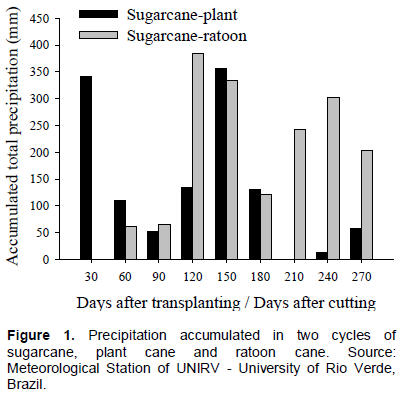
The IAC 95-5000 variety, with a variety of a very high agricultural production, rusticity, precocity, indicated for a favorable environments for erect growing, excellent ratoon sprouting, good tillering and between rows covering, resistance to the main diseases and not presenting tipping and flowering was used.
Soil collected from 0 to 0.20 m depth of a Rhodic Hapludox according to United States (2006), a Latossolo Vermelho distroférrico, loamy, Cerrado phase by the Brazilian soil classification EMBRAPA (2013) was used along with cattle manure, in a proportion of 3:1 v/v, respectively. The chemical characteristics of the substrate (soil + cattle manure) used in the pots are presented in the Table 1.
Experimental design and characterization of treatments
In plant cane, the experimental design used was randomized blocks, with three replicates, analyzed in 3x4 split plots. The treatments were combinations of three rates of water replacement (75, 50 and 25% of available water) and four N rates (equivalent to 0, 60, 120 and 180 kg ha-1 as urea, represented by D1, D2, D3 and D4, respectively); where the plots are the rates of water replacement (WR) and the subplots, the nitrogen rates (ND). The difference for ratoon sugarcane was the only subplots, which correspond to four residual N rates (applied in the previous cycle), being 0, 60, 120 and 180 kg ha-1, equivalent to the pots.
Fertilization of plant cane
All the N fertilization was done manually in accordance with their due treatments. There was planting fertilization for the treatments D2, D3 and D4.The (D0) treatment is the N control, that is, without N. The topdressing N fertilization was top dressed at 45, 60 and 90 DAT in accordance with the respective treatments.
Fertilization of the ratoon sugarcane
The N fertilization of 120 kg N ha-1 (urea) was applied as in the cane plant, so as to match all treatments, to make it possible to assess only the N applied in plant cane cycle, evaluating in the first ratoon cane as residual N. This in turn was divided into two applications, the first at 30 DAC and the last at 70 DAC.
Water replacement
The irrigation was done by the drainage lysimeter method, using four pots for each replicate, totaling twelve pots (lysimeters).
The soils of pots were maintained at field capacity for 18:00 hours and the drained water was collected 12 h later. After the collection of the drained water volume of each pot, the data were applied to equation 1, to reach the field capacity of each pot and the average value was considered and extrapolating for the rest of the pots. The pots of reference (lysimeter) also received the plant and the treatments corresponding to each line of drip. All irrigations were performed in the morning.

The irrigation interval used was two days. This to ensure that the quantity of water to be applied was always proportional to the quantity sufficient to elevate the moisture to their respective treatments of 25, 50 and 75% field capacity of the pots. Field capacity was determined from each reference pots, established as 22 L.
At the end of the experiment the effective precipitation and the net water blade applied to the soil (via irrigation system) were calculated, for the period which the crop culture was not in the field. Whereas, an available water capacity (AWC) of 25 mm in a water catchment area of the precipitation of 0.2827 m2. For the total cycle of plant cane and ratoon cane the values of precipitation effective calculated for each pot were 337.60 mm and 484.70 mm, respectively.
The net blade of water for the WR of 75, 50 and 25% in plant cane the values were 824.35 mm, 662.1 mm and 499.85 mm respectively. For the first ratoon cane the values were 1033.70 mm, 850.7 mm and 667.7 respectively. Irrigation was done using drippers of a turbulent flow with the flow of 1.65 L h-1 to 1.0 bar, spaced 0.50 m, being installed in a lateral line of dripper for each treatment, giving a total of six lines of dripping, 10 m in length.
Analyzed variables
Productivity was determined through manual cutting with the aid of a digital dynamometer, precision of 20 g. The mass in kg of all the plants collected per pots, transforming it to productivity in t ha-1, using the area occupied by the pots (1.595 m2) was measured.
To determine the total recoverable sugar (TRS) of sugarcane, five plants were collected per pot, with a total of 60 whole culms per repetition, eliminating, only the pointer and the dry leaves. Then, stems were taken to the Center for Sugarcane APTA/IAC Laboratory, located in Piracicaba, SP for the technological parameter analysis used to estimate the gross income of sugar and alcohol, according to the instruction manual of the Council of Producers of Sugarcane, Sugar and Alcohol of the São Paulo State (CONSECANA, 2006).
For the calculation of the gross income of sugar and alcohol, the equation 2 and 3, respectively, were used:
Where: Productivity (t ha-1); GIS: gross income of sugar (t ha-1); GIA: gross income of alcohol (m3 ha-1); TRS: total recoverable sugars (kg t sugarcane-1).
Statistical analyzes
The data were submitted to analyze the variance and when the F test was significant, the mean Tukey test (0.05 probabilities) was proficient for the water replacement factor, due to the fact that there were only three rates. For the N rate factor, linear and quadratic polynomial regression test were applied. The statistical software SISVAR-ESAL® (Ferreira, 2011) and the SigmaPlot®11 (Systat Software Inc.) were used.
According to Table 2, the interaction between the N rates factor (ND), and water replacements (WR) were not influenced significantly for the variables analyzed in the plant cane. Due to the ideal conditions for growth and the use of the PSS method, the sugarcane plants remained in the field for about nine months, thus anticipating its cycle and reaching the ideal maturation index for the harvest up to 270 DAT. The fact that water replacements did not affect these variables could be explained by the following attributes: resistance to drought presented by the variety- Good water availability (from precipitation) which coincided with the time of maximum development of sugarcane (Figure 1): and high content of organic matter present in the soil (exceeding 5%) - according to Machmuller et al. (2015) one of the benefits of organic matter is to increase water retention capacity of a soil. Despite this result, the average values found for the TRS were satisfactory, ranging from 141.91 to 152.63 kg t cane-1. The maximum value was higher than that obtained by Moura et al. (2014), 151 kg ton cane-1, in WR of 75% and with NDR 100 kg ha-1.
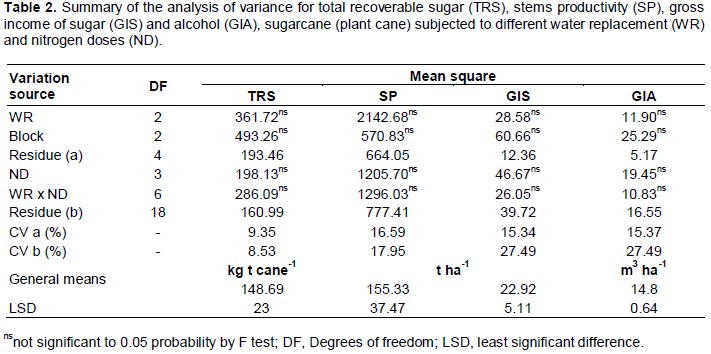
The results found for the TRS corroborate with Oliveira et al. (2011) and Moura et al. (2014), where irrigation did not influence the TRS in the plant cane circle. As reported in several studies, some sugarcane do not respond to N fertilization, both on crop yield and technological quality, because some factors such as the roots strength, organic matter mineralization and the biological N fixation are assigned to this behavior (Urquiaga, 1992; Silva et al., 2013; Rosa, 2012). In the face of these facts, the production and total recoverable sugars, which are part of the crop industrial quality reflected in the insignificance of the gross income of sugar and alcohol when subjected to the evaluated factors, since the calculation to reach these variables takes into account only the TRS and yield.
Table 3 is different from plant cane; the evaluated factors influenced significantly the analyzed variables of sugarcane in its cycle of first ratoon. It is observed that the interaction between residual N rates and water replacement in the TRS, GIS and GIA, influenced the productivity significantly only by water replacement. These results confirm that the ratoon cane responds to N fertilization and that the N applied in the previous cycle can be leveraged by sugarcane (residual effect), thus influencing the gross income of sugar and alcohol of crop.
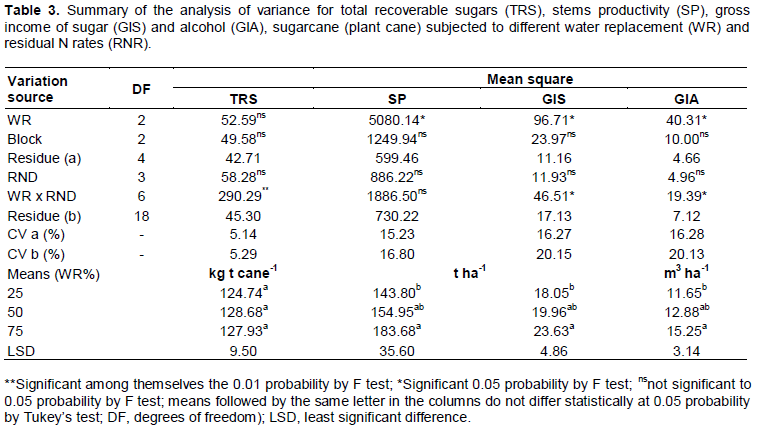
As the factors influenced the TRS and the SP, it was expected that the gross income of sugar and alcohol were also influenced, in view of the direct relation of these variables. Oliveira et al. (2016), studying productivity variables of sugarcane also noted an increase in sugarcane yield with increasing WR, reaching the value of 230 t ha-1 in the WR of 75%, higher than what was obtained in this study, 183.68 t ha-1. The comparison between these studies, however, is not feasible because of difference in used varieties and also considering that our experiment was carried out in pots. But the increase in productivity that promotes WR is clearly seen in both studies.
It was observed in Figure 2 the unfolding of the interaction between WR x RND. For water replacements within each level of residual N rates, there was a significant difference between the RND 60 and 180 kg ha-1, so that for these rates, the WR50% was statistically equal to WR of 25 and 75%, with difference only between the WR of 25 and 75% (Figure 2A). For the residual N rates within each level of water replacement, there was no difference between the WR of 25 and 75%, but only the WR25% adjusted to one of the models studied. The equation adjusted for this WR was to the quadratic, so that there will be a decrease in the TRS until the RND of 67.5 kg ha-1, noting that when using a low WR (25%), in ratoon sugarcane, the N fertilization up to 140 kg ha-1 in the preceding cycle is not favorable for the TRS of ratoon cane but the RND above this N rate provide increment quite expressive, so that for the RND of 0, 140 and 180 kg ha-1, the TRS estimated in WR of 25% was 122.6, 124.0 and 138.8 kg t cane-1, respectively (Figure 2B).
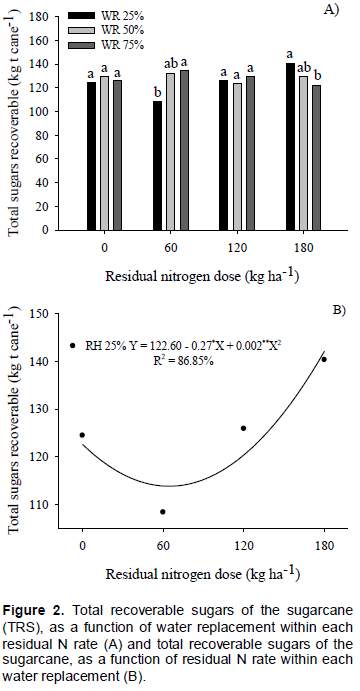
For the GIS and GIA, the unfolding of RND within each level of WR did not submit any significance to the equations studied. For the unfolding of the WR within each RND, there was significant difference only in the rates of 60 and 120 kg N ha-1 (Figure 3A and 3B). The N rate that differed in the WR and presented higher values for incomes was the 75% which was not statistically different from 50%. The lowest values were found in WR, 25%, which was statistically not different from the 50% (Figure 3A and 3B). Silva et al. (2014), studying growth and yield parameters of sugarcane variety RB92579, under irrigation scheme in Brazilian Semi-arid, found a gross income of sugar and alcohol for the first ratoon of 20.89 t ha-1 and 15.01 m3 ha-1, respectively. This is very close to the general mean found in this study both for plant cane and the ratoon sugarcane (Tables 2 and 3).
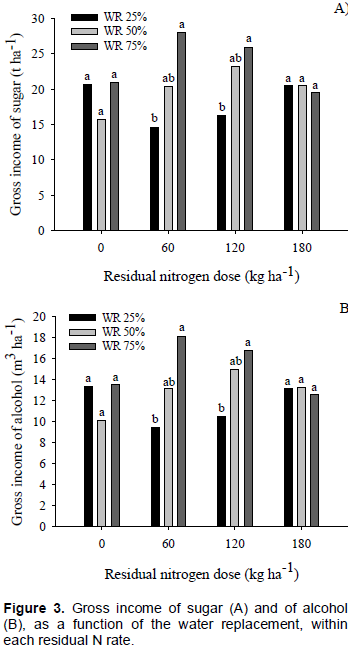
In accordance with the results of this study, the benefit of the N fertilization associated with the irrigation provides for the cultivating of sugarcane. These are responsible for the significant increase in the final product of commercial interest that is the sugar and alcohol. Taking into account a soil with at least 5% of organic matter, and assuming physical, structural, chemical and biological benefits, availability of nutrients mainly N, through mineralization (Lehmann and Kleber, 2015), it is recommended that for obtaining good agro industrial productivity with small quantities of soil N it is not necessary for N fertilization on plant cane. For the first cycle of ratoon cane, the recommendation of N fertilization is quite variable, because it will depend on the fertilization performed in planting, since that soil residual N influences the sugarcane yield from one cycle to the other. But what is clear is the need for applications of N fertilization in ratoon sugarcane, even with a soil rated with a high content of organic matter.
Regarding the use of irrigation, it is quite variable not depend on the sugarcane cycle, but on the distribution of rainfall, because, as observed, when there is a favorable distribution of rainfall particularly at the time of establishment and growth of sugarcane (fact occurring in plant cane) the minimum WR of 25% water, there is a certainty of achieving high yields, but when the distribution of rainfall is not so favorable (fact occurring in ratoon sugarcane), WR average of 50% is the most recommended.
The N applied on plant cane is utilized by the crop in the first ratoon cane (residual effect), but does not influence the stems productivity. Water replacements interact with residual N, so as to influence the total recoverable sugar and consequently the gross income of sugar and alcohol in ratoon cane.
The authors have not declared any conflict of interests.
The authors would like to thank the Ministry of Science and Technology (MCT), Brazilian National Council for Scientific and Technological development (CNPq) for funding the current essay. We are also grateful to the Brazilian Coordination for Updating of Higher Education Personnel (CAPES), to the Foundation for Research, Goiás State (FAPEG) and to Goiano Federal Institute, Campus Rio Verde, GO, Brazil.
REFERENCES
|
CONAB (2015). Companhia nacional de abastecimento. Acompanhamento da safra brasileira de cana-de-açúcar. Quarto levantamento. Accessed Oct. 12, 2015.
|
|
|
|
CONSECANA (2006). Conselho dos produtores de cana-de-açúcar, açúcar, álcool do estado de São Paulo. Manual de instruções. 5 ed. Piracicaba, 112 p.
|
|
|
|
|
EMBRAPA (2013). Empresa Brasileira de Pesquisa Agropecuária. Centro nacional de pesquisa de solos. Sistema brasileiro de classificação de solos. RJ. 306 p.
|
|
|
|
|
Ferreira DF (2011). Sisvar: a computer statistical analysis system. Ciência e agrotecnologia (UFLA) pp. 1039-1042.
|
|
|
|
|
Franco HCJ, Otto R, Faroni CE, Vitti AC, Oliveira ECA, Trivelin PCO (2011). Nitrogen in sugarcane derived from fertilizer under Brazilian field conditions. Field Crops Res. 121:29-41.
Crossref
|
|
|
|
|
Lehmann J, Kleber M (2015). The contentious nature of soil organic matter. Nature 528(7580):60-68.
Crossref
|
|
|
|
|
Machmuller MB, Kramer MG, Cyle TK, Encosta N, Hancock D, Thompson A (2015). Emerging land use practices rapidly increase soil organic matter. Nat. Commun. P 6.
Crossref
|
|
|
|
|
Moura LC, Silva NF, Cunha FN, de Campos BFJ, Célia JA, Teixeira MB (2014). Maturation index sugar cane fertirrigated under different blades. Rev. Bras. Agric. Irrigada-Rbai 8(1)64-76.
Crossref
|
|
|
|
|
Oliveira AR, Braga MB, Walker AM (2015). Vegetative behavior and technological quality of sugarcane cultivars under water stress in Brazilian semi-arid. Rev. Bras. Geografia Física 8:525-541.
Crossref
|
|
|
|
|
Oliveira ECA, Freire FJ, Oliveira AC, Simões Neto DU, Rocha AT, Carvalho LA (2011). Productivity, water use efficiency, and technological quality of sugarcane subjected to differents water regimes. Pesqui. Agropecu. Bras. Brasília 46(6):617-625.
|
|
|
|
|
Oliveira RC, Da Silva NF, Cunha FN, Teixeira MB, Soares FAL, Di Campos MS (2016). Effect of water replacement and nitrogen fertilization on productivity variables of sugar cane. Afr. J. Agric. Res. 11(8)633-643.
Crossref
|
|
|
|
|
Rosa HJA (2012). Use of active crop canopy sensor to detect sugarcane responsiveness to nitrogen supply. 73. Dissertação (mestrado em ciências) - Escola Superior de Agricultura "Luiz de Queiroz. Universidade de São Paulo, Piracicaba.
|
|
|
|
|
Silva NF, Moura LC, Cunha FN, Ribeiro PH, Carvalho JJ, Teixeira MB(2014). Industrial quality of sugar cane fertirrigated under different blades of water in southwest goiano. Rev. Bras. Agric. Irrigada 8(3)280-295.
Crossref
|
|
|
|
|
Silva TGF, Moura MSB, Zolnier S, Souza LSB (2014). Accumulated dry biomass, partitioning and industrial yield of irrigated sugarcane in the Brazilian Semi-Arid. Rev. Ceres 61(5):687-696.
|
|
|
|
|
Teodoro IT, Neto JD, Souza JL, Lira GB, Brito KS, Sá LA, Santos MAL, Sarmento PLVS (2013). Yield isoquants for sugar cane as a function of irrigation and nitrogen fetilization. Irriga - Brazilian J. Irrag. Drainage 18(3):387-401.
Crossref
|
|
|
|
|
Urquiaga S, Cruz KHS, Boddey RM (1992). Contribution of nitrogen fixation to sugar cane: nitrogen-15 and nitrogen balance estimative. Soil Sci. Soc. Am. J. 56(1)105-114.
Crossref
|
|
|
|
|
Wiedenfeld RP (1995). Effects of irrigation and N fertilizer application on sugarcane yield and quality. Field Crops Res. 43:101-108.
Crossref
|
|